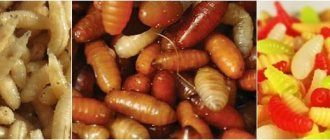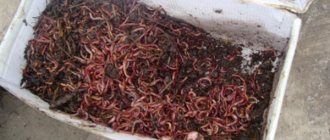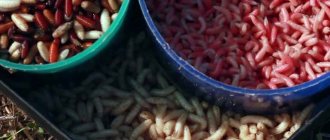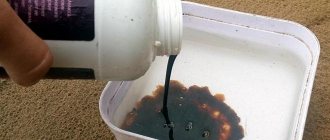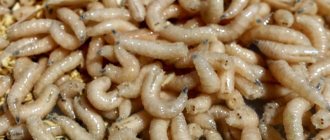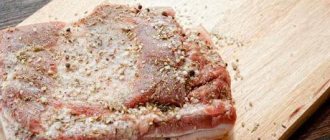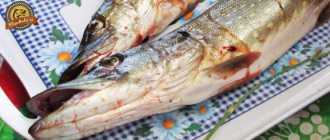Despite the fact that maggots can be purchased today in almost every fishing store, breeding them at home has not lost its relevance.
Firstly, not all stores offer maggots of adequate quality. Very often, having bought a bag of larvae, a fisherman discovers among the sawdust some maggots that have already pupated, and some that are loose and barely alive.
Before reaching the counter, maggots go through quite a long journey from the manufacturer through intermediaries, and along the way, the requirements for its storage are not always met. In many stores, maggots are regularly sorted out and sold, first of all, those that are, as they say, “living out their last days.”
Secondly, a fisherman who breeds maggots on his own can be absolutely sure of the purity and sterility of the larvae. And thirdly, home breeding of maggots can be economically profitable.
After all, maggots are used not only as bait, but also as an effective bait when fishing for carp, and in this case, you will have to buy it for hundreds of rubles, which not every angler can afford.
How to get maggots at home?
Breeding maggots yourself is not such a difficult and troublesome task as it might seem to someone at first glance. As for the “aesthetic” side of the issue, there are not much more problems here than, for example, when harvesting dung worms.
It is advisable to carry out all work with thin latex gloves, and keep starch, small sawdust or wheat bran on hand, which significantly simplify all operations with larvae.
For fishermen with a particularly sensitive sense of smell, we can also recommend a respirator. You can also use tweezers, preferably plastic ones.
Using an egg
One of the simplest ways is to breed larvae in a chicken egg. To do this, take a hard-boiled egg, cut off the top and leave it in places where flies gather.
It is not recommended to take a raw egg, as some authors advise - it does not spoil for a very long time and attracts few flies. Flies lay eggs in a boiled egg quite quickly, and in warm weather, within a week you can shake a small portion of maggots out of the shell.
A significant disadvantage of this method is the foul smell of hydrogen sulfide, which produces a rotten egg and a negligible yield of larvae from one egg.
In a bottle
It is much more convenient to breed maggots in a plastic bottle. There are many options here. The easiest way is to take a PET bottle (1.5-2 liters) and cut off its upper part so that you get a funnel.
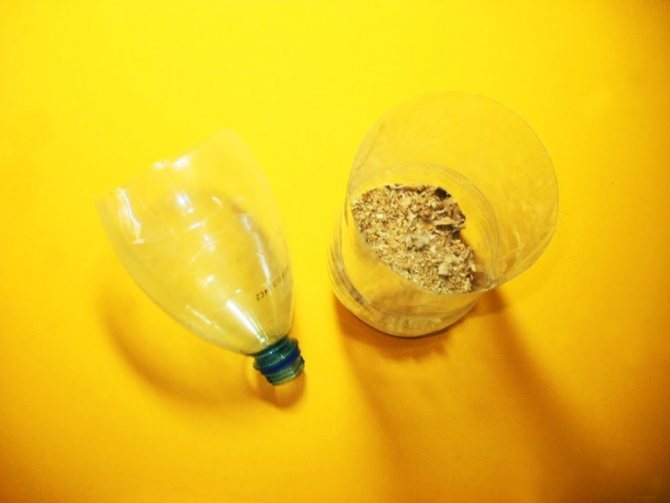
This funnel is inserted into the cut part of the bottle. Flies will fly into the container through the neck. Bait for flies is placed in the cut part of the bottle - it can be fish, meat, or minced meat. A little sand and sawdust is immediately poured onto the bottom. It is not worth covering the nutrient substrate itself with sawdust. For example, meat covered with sawdust will begin to attract flies no earlier than a week later, since sawdust delays putrefactive processes and absorbs odors.
It is advisable to place the bottle in a secluded place so that it does not attract the attention of household members. Various country houses are ideal. In the city, of course, the only suitable place is a balcony. The bottle needs to be shaken periodically and checked to see if larvae have appeared. In summer they grow very quickly, and if you miss the moment, they will turn into pupae, or even adult flies.
Typically, the larvae grow to working size within 3-4 days after the flies lay eggs. You can delay their development by putting the bottle in a cool place. After the flies lay their eggs, the neck of the bottle needs to be covered with several layers of gauze, since not only fish love them, but also predatory little beetles, which can easily destroy your entire strategic supply of bait.
You can cover the bottle with a plastic bag, but not tightly. Rural fishermen should also not forget that rats are very fond of maggots.
In some articles there is a recommendation to place a piece of meat or fish directly in the funnel. According to the authors, maggots from the funnel should themselves fall to the bottom of the bottle as they grow.
In practice, most of the larvae often remain in the funnel, from where they can easily crawl out or become easy prey for little beetles.
The method itself, of course, has a right to exist, but in practice it is not as convenient and simple as they say about it. When the larvae grow up, they are removed from the bottle. Partially you can shake them out, for example, onto a newspaper, partially you have to pick them out with your hands from the remnants of meat or fish.
Do not forget that maggots spread quickly, so you cannot leave them unattended for even a minute. The maggots are poured from the newspaper into a jar and covered with sand mixed with sawdust. The jar is tightly closed with a lid and turned upside down. The maggots, having passed through a layer of sand and sawdust, will be cleaned and practically get rid of the unpleasant odor. After this, the jar is turned over to its normal position and the larvae are transferred to any suitable box with a tight lid.
Maggot in the bone
There is an old, original method of breeding maggots in bones. A raw, fresh tubular bone with remaining meat is taken. It's good if it has already started to deteriorate.
The bone is split with an ax, but not completely, but so that a crack forms in it. The bone is lightly sprinkled with earth or sand. Blue flies quickly lay eggs in it, and the larvae grow, feeding on the remains of the meat.
Numerous theorists argue that maggots will certainly crawl inside through the crack, and the fisherman will only have to shake them out before fishing from a “completely bare bone.”
In practice, only part of the maggots is taken inside the bone, while others remain outside. In addition, by the time the bone is completely eaten away, some of the maggots will already have time to pupate. Another disadvantage of this method is the absolute availability of both bones and maggots for the same little beetles, as well as larger predators.
Maggot in the liver
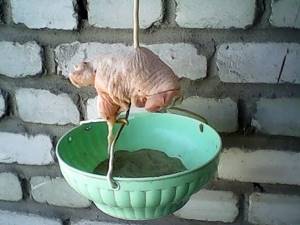
Much more reliable is another ancient method of breeding maggots - in a piece of liver. Using a sharp knife, cuts are made in the liver into which wooden splinters are inserted - spacers.
A piece of liver is placed in any suitable container (in old books they wrote “pot”) and covered with a cloth. Sawdust or its mixture with bran should also be poured into the bottom of the container.
In warm weather, the larvae usually appear on the 2-3rd day, after which it is important to monitor the process daily so as not to miss the moment when the maggot is “ready” for fishing. Instead of liver, you can use a piece of light or spoiled meat.
Maggot in fish
Of course, the simplest and most accessible for every fisherman is breeding maggots in fish. It is enough to simply spread the fish cut lengthwise in the open air.
In “flying” weather, a few hours will be enough for flies to lay eggs. After this, the fish is tightly wrapped in several layers of paper (newspaper will also do) and placed in a large glass jar with sawdust sprinkled on the bottom.
The jar can be closed with gauze, paper or a lid with holes. The holes should also be covered with gauze or paper. In the summer, after a few days, some of the maggots will begin to escape from the newspaper and crawl along the bottom of the jar. So it’s time to get ready to go fishing. A glass jar is convenient because you can visually control the process.
Maggot can also be obtained from salted fish. Any fisherman who has been drying fish has at least once in his life encountered the fact that, despite all the measures taken, flies managed to lay eggs in the hung fish.
It is these maggots that come out the densest and most elastic. Even a high concentration of salt does not harm them at all. “Salted” maggots grow a little longer than usual, but they are the largest and do not pupate for a long time.
In addition, they have virtually no characteristic unpleasant odor. Apparently, the preservative effect of salt is affecting. Perhaps this is one of the best ways.
Blank - container from a container
This method of breeding maggots at home implies the presence of the liver of horned animals of any freshness.
The most important thing is that it is raw. First of all, this is due to the fact that the larvae love to eat flesh. This option for self-breeding maggots is also very simple. To implement it, you will need a plastic bottle cut into two halves and a number of simple manipulations that can be done at home.
- The cork is screwed off the plastic bottle, and sawdust is poured into the cut-off lower part.
- The upper part of the bottle is inserted with the neck into the lower half with sawdust.
- Meat or liver is placed in the funnel of the upper part and everything is taken out onto the street or balcony.
- After passing for two to three hours, the bottle is carefully inspected for the presence of a clutch of fly eggs. If the clutch is discovered, the bottle is removed into the shade.
- After 3-4 days, the maggots will grow and slide into the lower part of the bottle with sawdust.
- Blue fly larvae are moved to a more convenient container and then fed with meat or curd product.
The grown larvae are washed and sprinkled with fresh sawdust. After this, you can take the bait fishing and be sure of a good bite.
These are also called traps. I decided to try two options: from a plastic container and a PET bottle. To begin with, I made small working models.
Next, either get larger or increase the number of traps. Cut a 2-liter bottle at the top. Ideally, it is better to use a dark beer so that the interior space is shaded, I used a transparent one for clarity. The lower part will be the main pallet, so that it can be hung, we make small eyes with scissors.
We thread a loop in the form of a leash made of thick fishing line.
The upper part will be turned over and inserted into the trap with its neck down; its main task is to prevent the maggot from crawling out when it becomes too active. I cut off the neck to make it easier for flies to get to the raw material. Pour a layer of sawdust (not pine) into the container, about 10-15 centimeters. I used wheat bran.
And here's what you need to know: Bream hook size, number, shape and other characteristics
Beat in 3-4 raw eggs and use a stick to mix them with the top half of the sawdust/bran. There should be some dry “litter” left at the bottom. If you wish, you can also add a little meat or fish to the egg mixture, for example, a couple of small roaches.
It is advisable to use a container with high walls. We make a removable box from a fine-mesh mesh, which is slightly submerged inside the vessel. The holes must be such that an adult maggot, which will be used for attachment or added to fishing bait, can fit through at least 3 mm.
Pour the litter - a little, a few centimeters.
We put something protein on the grid. Poultry giblets, chicken, meat, fish, etc. are suitable. There was minced pork available, so it went into action.
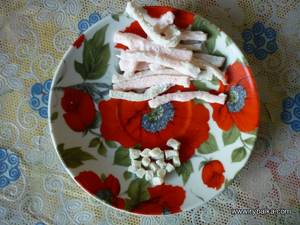
Cover with a lid (for shading only). In the same way, we tie a loop of fishing line through the punctured holes in the side walls.
Many avid fishermen, who have already gone through the stage of endless purchases of bait, as well as growing it without special equipment, try to construct maggots. With their help, odorless maggots and sticky substrate are grown. More precisely, maggots allow less contact with them.
Such devices allow you to grow bait at home without creating much inconvenience. You can make maggots without much difficulty. This will require minimal investment of money and time.
The design includes three containers that are placed one inside the other:
- The upper container has multiple holes in the lid and bottom. It is used to place fish or meat;
- A layer of large sawdust or wood shavings is placed in the middle container. The layer thickness should be 5-7 cm. The bottom, as in the first case, should have multiple holes;
- The lower container is for ready-made worms. Sawdust is also poured into it.
And here's what you need to know: Special rotating spoons - Devons, propellers, turbines
The principle of growing larvae in such a device is very simple and requires minimal human intervention. There is no need to look for what maggots eat, since everyone has everything they need at home.
Using chicken eggs, you can quickly and easily stock up on larvae. Of course, you can’t make a business out of maggots this way, but you can get hold of a small amount of valuable bait. The process is simple:
- Hard-boil a large chicken egg, cool.
- Remove part of the shell (only from the top of the egg).

Photo 1. Prepared egg. - Place the chicken product in fresh air (preferably in a little shade).
- After 2 days (if it’s warm), the egg will go rotten, and a blue fly will certainly fly to the smell and lay a clutch.
- The larvae hatched in the egg are ready for fishing - the shell will not allow them to crawl.
This method of growing maggots at home is not bad, but only when you need a few larvae. Otherwise, you will have to stock up on a few rotten eggs.

Interesting! Do maggots reproduce? You should not expect an increase in their number - the larvae will not reproduce, only flies can emerge from them.
Growing maggots at home can be turned into a fun process using an ordinary plastic bottle (it is better to take a transparent container so that you can observe the results). How to make a kind of “incubator” with your own hands?
Cut the bottle into two parts (crosswise).
Pour a few handfuls of sawdust into the bottom one (dry it first), remove the lid from the top one and insert it neck down into the “cup.”
Place the liver (several slices of meat, pieces of fish) in the upper part and take the “incubator” out into the fresh air. A few hours are enough for the flies to lay eggs, after which you take the homemade structure to a dark place.
After a few days, larvae will appear (this is easy to check - they will slide down the walls into the “cup”). It is better to pour sawdust along with maggots into a large container. You can feed the larvae a little so that they are fatter and larger. What to feed the larvae? You can take cottage cheese, small pieces of meat. You need to feed maggots up to four times a day - they absorb food quite quickly.
Flavoring maggots
Natural maggot itself has a smell that is more than attractive to fish, but many fishermen cannot deny themselves the pleasure of experimenting and adding a new aroma to old bait.
You can use any flavorings - from the textbook anise oil and valerian to branded attractants that are sold in fishing stores.
You can simply spray the maggot with the selected flavoring agent, or you can moisten the sawdust in which it is located. A number of authors recommend boiling sawdust in water with added flavoring and then drying it.
The recommendation is more than controversial. Most flavorings are volatile substances and, when cooked, will either lose their aroma or completely evaporate. In addition, cooking followed by drying takes a lot of time and does not guarantee results. In general, it has been noticed that many fishermen flavor maggots not so much for the fish, but for themselves. This is understandable. After all, it is much more pleasant to bait a maggot on a hook, fragrant with the aroma of vanilla and coriander.
Coloring maggots
Stores, as a rule, sell not only naturally colored maggots, but also colored ones - most often red. You can paint maggots almost any color at home.
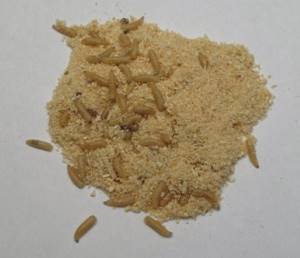
To this day, in print and online publications you can find recommendations for coloring maggots using highly complex technologies: degreasing, soaking and “washing” the larvae in various solutions, followed by coloring.
Most likely, such recommendations are nothing more than the fruits of the imagination of theorists, because any practicing fisherman knows that maggots always take on the color of the substrate on which they feed or are kept. All you need to do is purchase in a store, for example, an “Easter Egg Set” with multi-colored dyes - and you can start experimenting.
A dye of the desired color is added, for example, to a finely grated boiled egg or cottage cheese, and placed in a container containing maggots. In a few days you will get larvae of any color of the rainbow.
The dye can also be added to sawdust that contains maggots. Dyeing with this method takes longer and the color is less intense. For those opposed to food dyes, we can recommend, for example, finely grated beets. True, the color will not be too intense. However, food coloring does not cause any harm to maggots.
When using home methods for coloring maggots, it can always return to its natural color - just transfer it to clean sawdust or bran. After some time, it will gradually clear of paint. Industrially dyed maggots retain their artificial color under any conditions.
Maggot breeding business
This method of breeding maggots at home attracted fishermen for its simplicity. In this case, all that is required is to purchase one egg, and nature will do the rest for the person. But this method of breeding fly larvae has a significant drawback - you cannot grow a lot of live bait for fishing in one egg.
There are five main types of obtaining maggots at home:
- Using an egg. This is probably the simplest way to grow maggots at home. To do this, take an ordinary chicken egg, boil it, and cool. After this, you need to literally remove the shells at the top a centimeter and after that, place them in the shade outside. The egg should rot quickly this way. Immediately after it goes rotten, flies will begin to lay their larvae in it. This way you will get a good maggot as quickly as possible.
- In a bottle. To do this, take an ordinary two-liter bottle - it must be clean. Beer bottles are ideal. Holes with a diameter of 3.5-4 cm are cut at the top, giblets or meat are thrown in there and hung somewhere in a dry place. The flies literally immediately fly in and begin laying larvae. But under no circumstances should you get it wet.
- In the bones. This is the most difficult way to grow maggots, since there is a lot of smell, the growing time is very long and the probability of appearance is very small, and if maggots appear, then there are very few of them.
- In the liver. To do this, take a piece of liver (or at least a lung). Cuts are made on it - most often horizontal - and hung on a hook on the street. After waiting just two days for the flies to lay their eggs, the liver (or lung) is removed and also placed in a bucket or pot that has been previously filled with sawdust.
- In fish. In order to use this method, you need to take a large fish and put it in a bottle. After this, the bottle with fish is put aside somewhere in the distance, since the smell will be simply unbearable. In this case, the best solution would be to take it outside and hide it with bushes. After this, you can transfer the maggots into a container with pre-prepared shavings.
If an angler has not had time to acquire maggot, do not be upset, as there are excellent alternative options for growing bait.
The devices can be made in a few minutes. To figure out what is best for growing maggots, you should consider several popular options.
Growing up in an egg
Every novice fisherman should know how to grow maggots using chicken eggs. This method requires a minimum of money, time and effort. The main disadvantage is that with one egg you can raise few larvae. Of course, to increase the volume of bait obtained, you can use more eggs.
On average, each egg produces 20-30 maggots.
You need to do the following:
- hard boil the egg and give it time to cool;
- remove the shell from its upper part and place it in a shaded place in the fresh air;
- after a while the egg will become rotten, and blue flies will flock to it and lay their eggs inside;
- soon the larvae will begin to hatch from the clutch, which will grow directly in the shell without falling out;
- When it reaches marketable size, the maggot is removed from the egg, after which it can be taken fishing.
Eggs can be placed in a specially prepared container with sawdust. In this case, if the larvae are able to get out of the shell, they will fall into the sawdust.
Maggots in the liver
This method will cost a little more, since you will need to sacrifice an entire liver. You need to do the following:
- prepare fresh or stale liver, preferably from cattle;
- hang on a hook from a branch of a tree and leave for 2-3 days;
- when the flies make a clutch, the liver must be transferred to a closed container, first pouring sawdust into it;
- after hatching maggots from eggs, you need to add bran to them and leave until they grow to 8-10 mm;
- then they must be transferred to another open container with bran;
- You need to feed them meat for a few more days.
Growing maggots in fish
Fish in this case is used in a similar way. You also need to hang it on a branch, wait until it goes rotten and the flies lay eggs. The main condition is that it must have a head, since the laying is done in the gills.
After the blue flies have done their job, the fish is removed from the hook and wrapped in several sheets of paper or newspaper. Within 3-5 days, maggots grow and spread.
Breeding larvae in fish is very popular, since this method is considered one of the simplest.
Growing into bone
Some fishermen practice raising larvae in bones. It should be large and hollow, and preferably cracked on one side. You will also need to figure out what to feed the maggots at home.
The bone should be left outside and sprinkled with a little earth. After some time, the flies will lay their eggs inside. After a few more days, it will be possible to collect the larvae, transfer them to a container and, if necessary, grow them to the required size, having first figured out what to feed the maggot.
Dilution in a bottle
This method is also distinguished by its simplicity and low cost. To make the device, you need to take a used plastic bottle and cut it into two parts.
Sawdust is poured into the lower half to create a layer 5-7 cm thick. The lid from the upper half is unscrewed, after which it is inserted into the lower part with the neck down.
The upper part should not reach the sawdust layer by a couple of centimeters.
Feeding the maggot is provided with the help of dead fish, eggs, meat, expired sausage, etc., which are placed in the upper part of the device. Then the structure is placed in the shade in a place inaccessible to animals. After about a week, the larvae will be ready for fishing.
On sawdust
You will need meat or fish, cut into small pieces. They are laid out in safe places so that they are in direct sunlight. After a couple of hours, the flies will lay eggs and these pieces can be collected.
Meat and fish are placed in a pre-prepared container. They can be sprinkled with sawdust on top or the larvae can be given the opportunity to burrow on their own by placing the pieces on this loose material.
Since the larvae do not like the sun, they will try to quickly hide from it in the sawdust. After 5-7 days they will be ready to use for fishing.
For those looking to produce bait on a large scale, you will need to learn how to keep maggots to produce the best quality product possible.
Breeding maggots at home as a business is only possible if you have a specially equipped room. It must constantly maintain the required temperature (from 23 to 25 degrees) and ventilation. It is advisable for private individuals to do this in places remote from their residence. A suburban dacha plot would be suitable.
This kind of business can be done all year round, because growing maggots in winter at home, if you have everything you need, is just as easy as in summer.
The room must be equipped with special containers for hatching larvae and cages for keeping flies.
The mesh from which the cages are made must have small cells so that flies cannot escape. The frame for them is assembled from a metal profile or wooden slats. The walls must be equipped with special sleeves designed for placing or removing dishes with a substrate.
The bulk of the larvae are collected and sold, but some should also be left for pupation to maintain or increase the fly population.
It is necessary to install a refrigeration chamber in the premises for storing products that you plan to sell.
Breeding maggots on an industrial scale is inherently not much different from growing them for small businesses. The main difference is the scale.
Industrial maggot breeding is also different in that there are many experts monitoring the selection of flies in order to improve the quality of the product.
Do not forget that for flies and maggots to fully develop, you need to be well fed. Therefore, you should find out what maggots eat at home and at work, compare the costs of food and products, and then choose the most suitable food.
To get a fly larva at home, you need to have 150-200 grams of meat or fish. It is advisable that the meat be boneless.
The meat is then cut into pieces the size of a matchbox and placed in a plastic bag. To speed up the decomposition process of meat, it must be tied well and left in a warm place for 24 hours.
The temperature must be appropriate (not lower than room temperature) so that the process does not drag on.
After this, you should take the rotten meat, which has an unpleasant odor, and prepare it for the next stage. It would not be superfluous to remind you that such a procedure should not be carried out in an apartment or, especially, in the kitchen in front of your household, because everything will go into the trash can, and you may hear something about yourself that you are not even aware of.
To continue your efforts to breed maggots, you need to stock up on a low container, into which you should pour a little sawdust. Slightly rotten meat is placed on the bottom, and the vessel itself is covered with a rag so that flies can get to the meat and lay their larvae there.
The meat needs to be placed in a shaded place, where there are a lot of flies.
If it is hot outside, then the larvae may appear within a few hours, but if it is at room temperature, then they will have to wait several days. As soon as the larvae appear, you can move on to the next stage of cultivation - harvesting the “harvest” and further feeding the larvae.
To begin the fattening process, you should know something about the life of flies and their larvae, otherwise the results may turn out to be completely different.
The fly larva, during its life activity, can measure 10-15 mm and no more, so the desire to fatten the maggot to gigantic size can be discarded immediately. From the moment the larvae appear until it turns into a pupa, an average of 10-15 days pass, so there is not that much time, especially considering that there is a desire to go fishing with your maggot.
Therefore, you need to be in time before it begins to pupate. To understand and capture such a moment, it is necessary to monitor the behavior of the larva: if the larva behaves very actively, then the maggot is fresh, if the activity is significantly reduced, then it wants to turn into a pupa.
The maggot has a characteristic dark dot on its body that disappears before it begins to transform into a pupa. This may happen several days before.
It is advisable to know these subtleties, especially when you buy maggots in a store or market. It may happen that today you bought maggots, and the next morning, some of them may become pupae.
Having collected a kind of “harvest”, you can put the maggots to fatten. This is done as follows.
All larvae are moved to the next container, which must contain sawdust. While in sawdust, the larvae will always have a marketable appearance.
Before placing them in a container, it is advisable to make a note indicating the date. Maggots should be fed any food rich in proteins.
It can be a chicken egg, lungs, liver, etc. They feed him for 3-4 days, no more, because in the future he will refuse food, having reached his maximum size. The procedure is as follows: sawdust is poured into a container, food is laid out on top of the sawdust, and then the larvae are poured out.
Another very important nuance in growing maggots: you need to take care of them, constantly changing sawdust. Since he actively feeds during this period, he constantly releases waste from his life. Fresh litter will make it more attractive and increase shelf life. In addition, the container should be ventilated at this time so that they (the larvae) do not die from lack of oxygen.
After it has gained its weight and acquired the required size, the maggot is placed in a cold environment so that it cannot turn into a pupa. Low temperatures slow down the development process and sometimes stop this process. As far as we know, fly larvae can survive at a temperature of -30°C for two years and only then can they turn into flies.
Boiled maggot
In cases where it is not possible to keep maggot alive (for example, multi-day fishing in hot weather), they resort to boiling it. They cook maggots almost like dumplings, dipping them into boiling salted water (at the rate of 1 teaspoon of salt per half a glass of water).
As soon as the larvae begin to float, they are thrown onto a sieve and dried. Maggot preserved in this way can be used not only in summer, but also in winter by freezing it - it holds well on the hook.
However, it should be remembered that unlike, for example, jigsaw, which after cooking takes on the appearance of a boiled shrimp and sometimes becomes even more attractive to fish, boiled maggots cannot compete with fresh ones. It bites much worse than a live one.
Pickled maggot
Pickling maggots - so as not to write about this “amazing English method” - is a necessary measure that makes sense only in conditions when your supply of maggots has begun to deteriorate, and there is nowhere to get fresh ones.
The maggot is kept in a marinade containing about 10% vinegar for an hour and then slightly dried. You can add any flavorings to the marinade. Pickled maggots are stored very well, and that’s where all of its advantages over live ones end.
How to grow maggots in the liver
In a special industrial complex, the larvae are usually raised using meat or liver. Maggots grown under such conditions are larger and fattier.
How to breed maggots in the liver? The most suitable is cow's, but you can get by with pork. No liver found? You can take regular meat (it doesn’t matter whether it’s fresh or slightly flavored). Leave the liver hanging outside for a while. In 2 days, the flies will have time to lay a lot of eggs, all that remains is to put the meat in a bucket of sawdust.
After emergence, the larvae will live in the same bucket, but you can add sawdust as they grow. Feeding with cottage cheese or meat waste will significantly speed up growth - within a week you can go fishing. To make the larvae live longer, it is better to transfer them to a clay container filled with bran and place them in a cold basement.
Maggot pupa
Pupation of maggots is the most common problem when storing them. The main reason for pupation of larvae is too high a storage temperature.
As a rule, regularly sorting out maggots, many fishermen throw out the pupae as unnecessary, not even suspecting that this is a pretty good bait, especially when fishing for carp on a feeder.
The caster, as the pupa is called, is placed on a hook, usually as part of a sandwich with other baits. If you have a lot of pupated larvae, they should be added to the bait mixture - they have a strong odor that attracts fish no less than the maggot itself.
A completely blackened caster is also only suitable for bait, since it is almost impossible to attach it to a hook.
Refrigerator as a storage method
Storing maggots in the refrigerator is the most famous and accessible way. You need to keep it in a tightly closed box or special container, sprinkled with fine sawdust or bran.
Some fishermen use dry wheat or barley groats. Ventilation holes should be minimal - maggots can be easily removed even through the holes in standard “Saiver” type foam moths.
You can store bloodworms in containers without any ventilation at all - you just need to open them periodically. In stores, as you know, maggots are sold in plastic bags with latches, but they do not die.
Storing maggots in winter
The refrigerator is traditionally considered the ideal place to store maggots, but this is not entirely true. In order to preserve maggots all winter, it is necessary to maintain the temperature within 0 degrees, and the temperature in the refrigerator is usually +4, +5 degrees.
Of course, if pupation occurs at this temperature, it is very slow, but there may not be enough bait for the whole winter. In addition, storing maggots in the refrigerator often causes protest from some household members, who (totally in vain) see this as a threat to their health.
In such cases, you can make a “refrigerator” for the maggot from a box in which bottles with ice are placed. Bottles are replaced as the ice melts. In winter, such a “refrigerator” is placed, for example, on the floor near the balcony door.
A cooler bag is also a good option. If the maggot storage temperature is not lower than 0 and not higher than +3, then in a state of suspended animation it will be stored for as long as desired, but will instantly come to life in your warm hands while fishing.
Hooks for fishing with maggots
The choice of hook depends on the specific object being fished; here the rules remain the same. But there are a number of features related to how to attach maggots for fishing. The basic requirements are:
- The size is small, depending on the number of maggots on it it can vary from 20 to 14 numbers, although for large fish numbers up to eight are required
- Ideal sharpening When piercing the body of a maggot, one must understand that safety can be ensured only with care, without serious damage
- The presence of a barb on the shank of the hook will prevent the bait from slipping and being removed by the fish.
Read! Catching chub with a cockchafer
The methods of planting maggots themselves are fundamentally different. For one end from the side of the head and through the entire body. For a large object, a so-called “pie” of several larvae is planted. But if you are taking maggots for the first time, it makes sense to practice a little before going out onto the pond. And don't forget about feeding!
